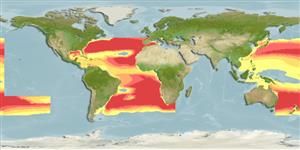>
Stomiiformes (Lightfishes and dragonfishes) >
Stomiidae (Barbeled dragonfishes) > Melanostomiinae
Etymology: Bathophilus: Greek, bathys = deep + Greek, phyle = dear, friend of (Ref. 45335).
Environment: milieu / climate zone / depth range / distribution range
Ecología
marino batipelágico; rango de profundidad 0 - 4900 m (Ref. 58018). Deep-water; 45°N - 48°S
Eastern Atlantic: Portugal south to Mauritania. Western Atlantic: USA to Bahamas. Northwest Atlantic: Canada (Ref. 5951). Southwest Pacific: New Zealand (Ref. 5755).
Tamaño / Peso / Age
Maturity: Lm ? range ? - ? cm
Max length : 18.0 cm SL macho / no sexado; (Ref. 4468)
Short description
Claves de identificación | Morfología | Morfometría
Radios blandos dorsales (total) : 13 - 16; Radios blandos anales: 14 - 17. Body cylindrical than compressed. Barbel very long and slender. Black to steely grey, with metallic sheen that may be purplish to greenish or bronzy (Ref. 37473).
Mesopelagic species (Ref. 4468).
Life cycle and mating behavior
Maturities | Reproducción | Spawnings | Egg(s) | Fecundities | Larva
Gibbs, R.H. Jr., 1984. Melanostomiidae. p. 341-365. In P.J.P. Whitehead, M.-L. Bauchot, J.-C. Hureau, J. Nielsen and E. Tortonese (eds.) Fishes of the north-eastern Atlantic and the Mediterranean. UNESCO, Paris. Vol. 1. (Ref. 4740)
IUCN Red List Status (Ref. 130435)
Threat to humans
Harmless
Human uses
Herramientas
Special reports
Download XML
Fuentes de Internet
Estimates based on models
Preferred temperature (Ref.
123201): 2.4 - 8.5, mean 3.7 °C (based on 1095 cells).
Phylogenetic diversity index (Ref.
82804): PD
50 = 0.5000 [Uniqueness, from 0.5 = low to 2.0 = high].
Bayesian length-weight: a=0.00302 (0.00117 - 0.00783), b=3.12 (2.89 - 3.35), in cm total length, based on LWR estimates for this (Sub)family-body shape (Ref.
93245).
Nivel trófico (Ref.
69278): 4.4 ±0.8 se; based on size and trophs of closest relatives
Resiliencia (Ref.
120179): Medio, población duplicada en un tiempo mínimo de 1.4-4.4 años (Preliminary K or Fecundity.).
Fishing Vulnerability (Ref.
59153): Low vulnerability (12 of 100).
